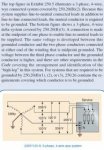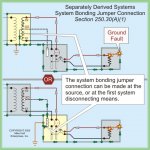Jerry Albertelli
Member
- Location
- Vidor
Here it goes.....I have a transformer where I have bonded the XO on the secondary (supply- side) with the case & grounding electrode. Now when I get to my First means of disconnect, then it becomes a separately derived system, right?
I am aware that I have to bond (unspliced) my XO with the ground and case-ground at the first disconnecting means, but can someone please tell me why I would have to bond at the transformer if I have to bond at the first disconnect or vise-versa??
I am aware that I have to bond (unspliced) my XO with the ground and case-ground at the first disconnecting means, but can someone please tell me why I would have to bond at the transformer if I have to bond at the first disconnect or vise-versa??



